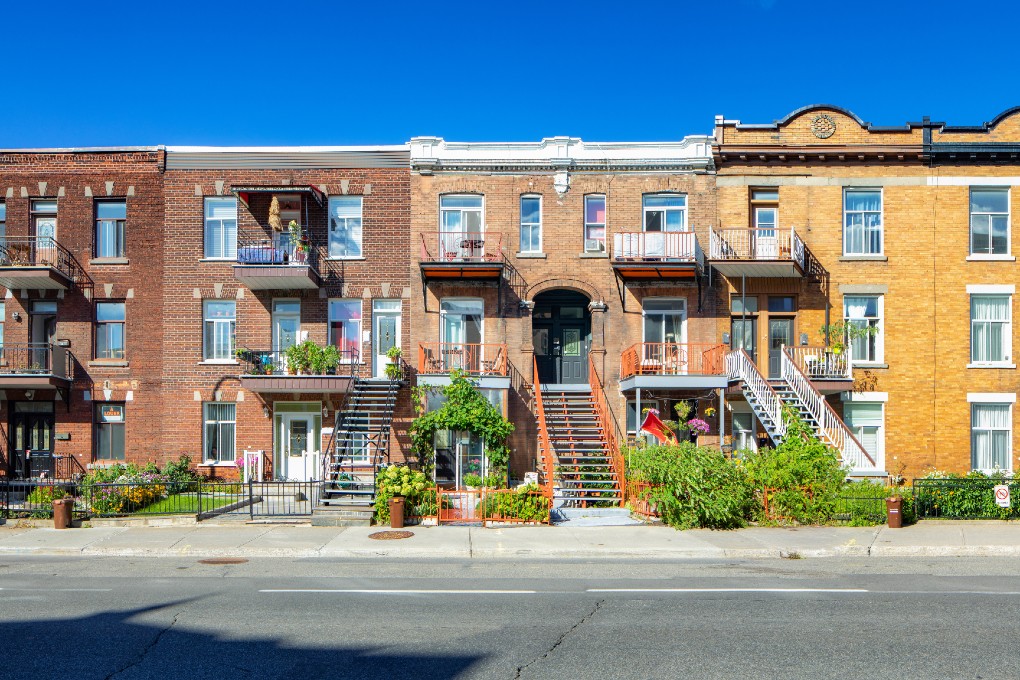
Are you thinking about investing in real estate to earn rental property income? Whether you invest in a residential or commercial building, there are several things to consider to make sure the property will generate a profit. Here’s what you need to take into account to determine how profitable an income property will be.
What factors determine how profitable rental property is?
Figuring out how much profit you can expect after buying a rental property with no more than four units or a building with five or more units involves much more than just subtracting expenses from income. Since this is a long-term investment, several factors will influence (positively, we hope) your building’s market value over time:
Location:
- Is the building in a good location? Is it in a popular, safe neighbourhood?
- Does the area have strong development potential or is it in decline? For example, property near a planned metro extension might increase in value.
- Is the property near a number of amenities, public transportation, a hospital, or a school?
Demand:
- Is the type of property you’re looking at in demand in that neighbourhood? For example, if there’s a commercial space on the building’s ground floor, make sure the building is on a commercial street and there are other stores nearby.
Rent:
- What is the building’s occupancy rate?
- How much rent do the tenants pay? A building with apartments rented below market price isn’t worth as much as one with higher monthly rents.
Tenants:
- Do all the tenants pay their rent on time?
- If there’s a commercial tenant, what business are they in? How long have they been there? Some financial institutions find certain business sectors to be risky.
- Are the leases evenly distributed? If one of the businesses occupies 80% of the leased units and its lease will soon be up, you may find yourself with a number of vacant units. Sometimes it’s better to have several small commercial tenants rather than one big one.
- Do the leases have short or long terms? Read them. If any of the leases will expire soon, you may end up with a vacant unit.
Condition of the building:
- To avoid any unpleasant surprises and possibly negotiate a lower price, have a certified building inspector inspect the property.
- Determine how well the building has been maintained. If the owner has hired a building manager and you want to keep them, this will be an additional cost that may lower your profit.
How do you calculate the profit on rental property?
There are several ways to determine your profit on income property; here are three quick preliminary assessment methods:
Debt-service coverage ratio (DSCR)
This is the simplest way to determine how profitable a building is. Just subtract all your annual expenses, such as mortgage payments, utilities, municipal and property taxes, maintenance costs, and insurance, from the total annual rent.
(Net Operating Income) divided by (Annual Debt Service) = (Debt Service Coverage Ratio)
As a general rule, a DSCR above 1.25 is often considered “acceptable,” whereas ratios below 1.00 could indicate that you’re facing financial difficulties. If income equals 125% of expenses, meaning you earn $125 in income for every $100 of expenses.
Bear in mind that this is merely a guide. Talk with an expert to make sure the building will generate enough profit.
Gross income multiplier (GIM)
The gross income multiplier (GIM) is a quick way to calculate rental property income.
The formula is simple: divide the building’s purchase price by annual gross income.
(Sales Price) divided by (Gross Operating Income) = (Gross Income Multiplier)
A good GIM ratio is between 4 and 7. A lower GIM means you’ll take less time to pay off your rental property.
While simple, this ratio is not the most accurate because it doesn’t take all of your building-related expenses into account. However, it’s an easy way to compare similar buildings in different areas.
Discount rate (OCR)
We recommend using the discount rate for commercial buildings and buildings with 12 or more residential units.
This is another simple calculation: divide the net income generated from the building by its market value.
(Net Operating Income) divided by (Sales Price) = Discount Rate or (Overall Capitalization Rate)
The discount rate is used a lot for comparison purposes. For example, you can compare your desired building’s discount rate with market discount rates by building type and location.
How can I make my rental property more profitable?
To make a rental property more profitable, you have to analyze your costs and operations first, and all the available options second. For example:
Know your market rents
Rental income will be your bread-and-butter, so you need to know the area’s average rent. Make sure any property you consider can bear enough rent to cover your mortgage payment, taxes, and other expenses. Research the area well enough to gauge where it might be headed in the next five years.
Raise the rent
Let’s talk first about raising the rent. This might be an option, but it might make some of your long-term tenants move out. In addition, rent increases must comply with applicable law, be reasonable, and must respect tenants’ rights. Rent increases are warranted and easier to justify if you’ve renovated the units and maintain the building properly.
Separately meter the utilities
Suite metering, sometimes called sub-metering, allows property owners that supply utilities to account for tenants’ energy usage. Each tenant’s electricity consumption, rated in kilowatt-hours, is monitored by a separate meter. Tenants are then fairly billed for, and responsible for paying, their own utility costs.
Always consider property taxes
Property taxes likely will vary widely across your target area, and you want to be aware of how much you’ll be losing. High property taxes are not always a bad thing—in a great neighborhood that attracts long-term tenants, for example, but there are unappealing locations that also have high taxes.
The municipality’s assessment office will have all the tax information on file, or you can talk to homeowners in the community. If you can afford the area now but taxes are expected to increase, an affordable property today could mean bankruptcy later.
Reduce your vacancy rate
If a neighborhood has an unusually high number of listings, it may signal a seasonal cycle or a neighborhood in decline—you need to find out which it is. In either case, high vacancy rates force landlords to lower rents to attract tenants. Low vacancy rates allow landlords to raise rents.
- Neighborhood
The neighborhood in which you buy will determine the types of tenants you attract and your vacancy rate. If you buy near a university, chances are that students will dominate your pool of potential tenants and you could struggle to fill vacancies every summer. Be aware that some towns try to discourage rental conversions by imposing exorbitant permit fees and piling on red tape.
- Locate near amenities
Tour the neighborhood and check out the parks, restaurants, gyms, movie theaters, public transportation links, and all the other perks that attract renters. City Hall may have promotional literature that can give you an idea of where the best blend of public amenities can be found.
- Avoid high crime rate neighborhoods
No one wants to live next door to a hot spot of criminal activity. The local police or public library should have accurate crime statistics for neighborhoods. Check the rates for vandalism, and for serious and petty crimes, and don’t forget to note if criminal activity is on the rise or declining. You might also want to ask about the frequency of a police presence in your neighborhood.
- Schools
Consider the quality of the local schools if you’re dealing with family-sized homes. Although you will be mostly concerned about monthly cash flow, the overall value of your rental property comes into play when you eventually sell it. If there are no good schools nearby, it can affect the value of your investment.
- Turn over units quickly
Taking too long to turn over units can get expensive when you consider you have to pay for the mortgage, utilities, repairs, housekeeping, and advertising while it is empty. Thus, finding new tenants quickly and avoiding extended vacancy periods will help you ensure maximum profits.
At the same time, you also want to ensure proper screening of all tenants. Evictions cost an average of $3,500 and can be taxing on your time. Although you want to avoid vacancies, a problem tenant is sometimes far worse.
Get a handle on repair costs
Being a landlord can be a good way to earn real estate income, but it’s not easy or glamorous. In addition to choosing the right property, prepping the unit, and finding reliable tenants, there are always maintenance hassles and headaches.
Do you know your way around a toolbox? How are you at repairing drywall or unclogging a toilet? Sure, you could call somebody to do it for you or you could hire a property manager, but that will eat into your profits. Property owners who have one or two homes often do their own repairs to save money.
Reduce insurance costs
Insurance is another expense you will have to subtract from your returns, so you need to know just how much it’s going to cost you. If an area is prone to erosion or flooding; or you’re paying for coverage you don’t use, insurance coverage costs can eat away at your rental income. Understand your needs; exactly what is covered and shop around for the best possible policy and service provider annually.
Improve the building’s energy efficiency
Doing work to improve the building’s energy efficiency, such as replacing doors and windows, might reduce your energy bills. That can help you increase your net income from the building.
Streamline your operating costs
Reducing your administrative costs can be another way to increase profitability. Review all your expenses, such as snow clearing, landscaping, and concierge or building manager costs. You may find budget items where you can cut costs and increase revenues.
Upgrade the units
By adding services or making the units more luxurious, such as by providing internet, a garage, or even storage, you might be able to raise rents.
What other factors affect rental property profits?
- The down payment you make on the building is a profitability factor. The bigger it is, the lower your mortgage payments will be and the more income you’ll earn from your building.
- The tax impact of the capital gain can also affect the profits you realize when you sell. When you sell your rental property you’ll be able to recoup the amortization expense, which is considered 100% taxable income. In addition, 50% of the capital gain is taxable. You’ll want to consider all this and expected profits when selling a property. That’s why it’s very important to understand how capital gain works. Talk to a tax lawyer or accountant about it.
- Tax exemptions for certain investments can also increase your income by reducing your taxes. For example, costs such as building renovation costs are tax deductible. That’s another factor that can make a building more profitable.
The Bottom Line
Be realistic in your expectations. As with any investment, rental property isn’t going to produce a large monthly paycheck right away, and picking the wrong property could be a catastrophic mistake. Still, rental properties can be a lucrative way to invest in real estate. For your first rental property, consider working with an experienced partner. Or, rent out your own home for a period to test your proclivity for being a landlord.
Taking the long view will also help you generate rental property income. For this type of property, supply, demand, and sales remain constant over time. Year after year, with regular maintenance, your building should increase in value giving you a return on investment when you sell.

